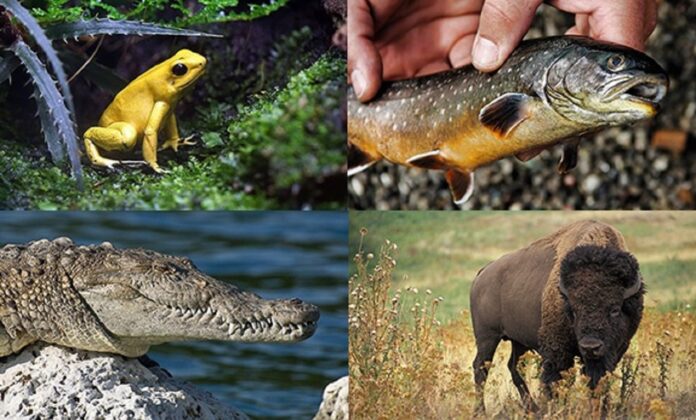A recent international study has shed light on the profound impact of human activities on the Earth’s ecosystems. The findings reveal a concerning “supersized” toll humans have exacted, highlighting the urgent need for global action. This study underscores the critical importance of understanding and mitigating the effects of human actions on the environment to preserve the planet’s delicate balance.
A recent global study has revealed that humans significantly impact vertebrate populations worldwide. The study indicates that over one-third of vertebrate species are being exploited by humans, posing a threat to the survival of more than 5,000 species. The research in Communications Biology examines how human predation through consumption and trophy hunting affects biodiversity. The findings highlight that humans take up to 300 times more prey species than previously thought, leading to disproportionate impacts on natural ecosystems. Consequently, the ecological functions performed by these overexploited species are now at risk due to human activities.
In a groundbreaking study, Dr. Boris Worm, a renowned marine ecologist and Killam Research Professor at Dalhousie University has co-authored the most significant comparison of human predation to other predatory species such as lions, tigers, and sharks. The study reveals a remarkable discovery regarding the extent of species exploitation by humans. The findings highlight the vast range of species that humans exploit, emphasizing our significant impact on various ecosystems.
Dr. Worm, explaining that the team looked at humanity’s overall ecological footprint or niche, said, “We’re an extraordinary predator in that our prey spectrum — the total number of species that we’re after — is in the order of 15,000 just for the vertebrates and we’re using many of those in an unsustainable way so much so that it threatens their survival. A niche is a species’ ecological operating space — where it lives, what it feeds on, and essentially the conditions it needs to survive. The point here is that humans use many more species than any other vertebrate — we have a supersized niche and are the most influential predator in many ecosystems.”
In a groundbreaking study, a team of scientists from 14 institutions globally has comprehensively analyzed human “use” patterns involving 45,000 vertebrate species across fish, mammals, birds, reptiles, and amphibians. Their findings reveal a stark contrast between humans and other top predators. While most predators primarily hunt for food, humans exhibit a broader range of uses for their prey species.
The researchers uncovered surprising results regarding land vertebrates, with the capture of terrestrial animals for the pet trade surpassing their use as food by nearly a two-to-one ratio. Co-author Chris Darimont, from the University of Victoria and Raincoast Conservation, emphasizes that humans have become the most exceptional predator on Earth, displaying behaviors and practices distinct from other carnivores. These include the killing or capturing prey for non-food purposes and the simultaneous endangerment of thousands of prey species.
A study reveals that sport hunting and other forms of collection contribute to the exploitation of approximately eight percent of terrestrial species. Fish and mammals are primarily used for food, while birds, reptiles, and amphibians are mainly targeted as pets. Dr. Boris Worm, a researcher involved in the study, shares a stunning example from his time in Indonesia, where the popularity of the Harry Potter franchise led to a surge in the exploitation of wild owls to meet the increased demand. Similarly, the film Finding Nemo had unintended consequences on the sales of pet reef fish, contradicting its message of preserving fish in their natural habitats. These cases demonstrate how cultural phenomena can inadvertently drive the over-exploitation of species, illustrating the potential consequences of our fascination with these creatures.
New research reveals the risks of overexploitation, including hunting for food and capturing animals for the pet trade. Overexploited species possess distinct traits such as large body size and a plant-based diet, making them vulnerable. The study underscores how humans endanger various ecologically important species, which could result in significant ecological changes. The research team suggests reimagining our relationship with animals and promoting sustainable practices among subsistence hunters and fishers while addressing the negative impacts of industrialized fisheries and unregulated pet trade. Conservation action plans should prioritize overexploited species with global ecological influence, recognizing the broader ecosystem implications of their loss.
The study also emphasizes ongoing discussions under the Convention on Biological Diversity to manage and mitigate these impacts. Dr. Rob Cooke highlights the far-reaching consequences, including losing seed dispersers like the Helmeted Hornbill and megaherbivores like the Black Rhino. However, the research concludes with optimism, as
Dr. Worm expresses hope in humanity’s growing awareness of our destructive actions and applying scientific knowledge to bring positive change for wildlife and nature, inspiring a brighter future for life on Earth.
Journal Reference:
- Darimont, C.T., Cooke, R., Bourbonnais, M.L. et al. Humanity’s diverse predatory niche and its ecological consequences. Communications Biology. DOI: 10.1038/s42003-023-04940-w.
